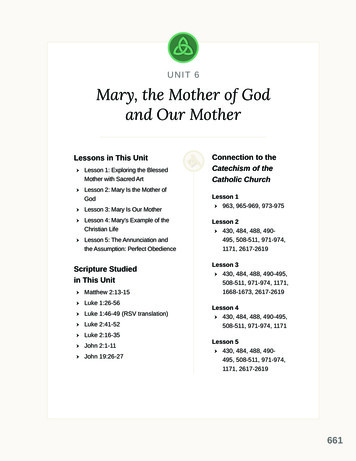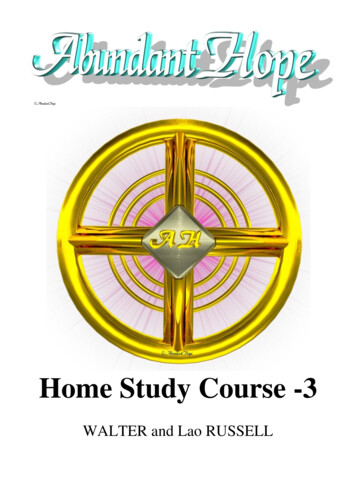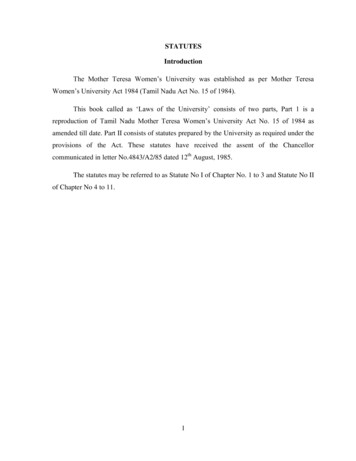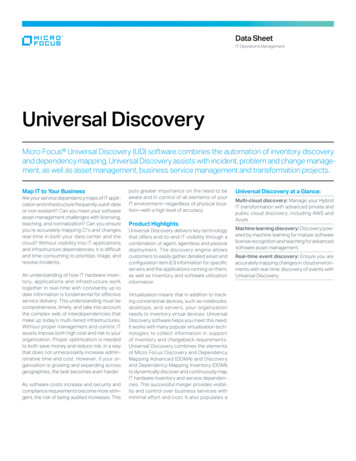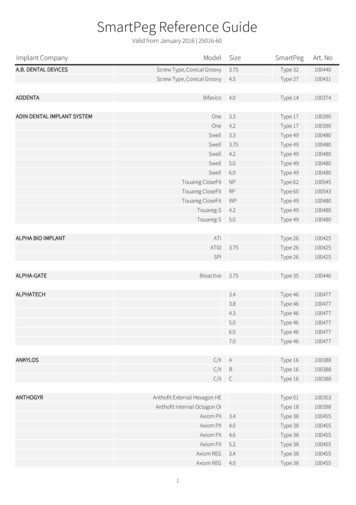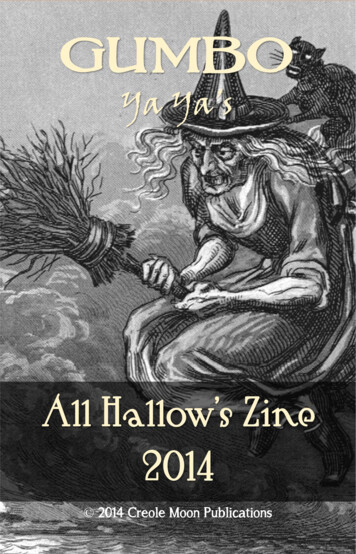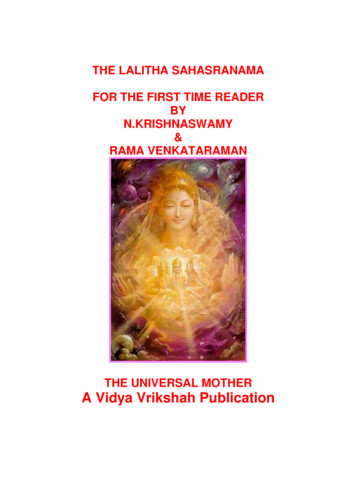
Transcription
THE LALITHA SAHASRANAMAFOR THE FIRST TIME READERBYN.KRISHNASWAMY&RAMA VENKATARAMANTHE UNIVERSAL MOTHERA Vidya Vrikshah Publication
AUMIS THE SYMBOL OFTHATETERNAL CONSCIOUSNESSFROM WHICH SPRINGSTHYCONSCIOUSNESS OFTHISMANIFESTED EXISTENCETHIS IS THE CENTRAL TEACHING OF THE UPANISHADSEXPRESSED IN THE MAHAVAKYA OR GREAT APHORISMtt! Tv AisTHIS SAYING TAT TVAM ASI TRANSLATES ASTHAT THOU ARTDedication by N.KrishnaswamyTo the Universal Mother of a Thousand ation by Rama VenkataramanTo my revered father, Sri.S.Somaskandanwho blessed me with a life of love and purposeACKNOWLEDGEMENTOur gratitude to Alamelu and C.L.Ramakrishanan for checking the contents to ensure that theywe were free from errors of any kind. The errors that remain are, of course, entirely ours.
THE LALITHA SAHASRANAMALIST OF CONTENTSTOPICSPrefaceIntroductionThe Lalitha Devi storyThe Sri ChakraSLOKA TEXT :Slokas 1 -10Names 1 - 26Slokas 11 -20Names 27 - 48Slokas 21 -30Names 49 - 77Slokas 31 -40Names 78 - 111Slokas 41 -50Names 112 - 192Slokas 51 -60Names 193 - 248Slokas 61 -70Names 249 - 304Slokas 71 -80Names 305 - 361Slokas 81 -90Names 362 - 423Slokas 91 -100Names 424 - 490Slokas 101 -110Names 491 - 541Slokas 111 -120Names 542 - 600Slokas 121 -130Names 601 - 661Slokas 141 -140Names 662 - 727Slokas 141 -150Names 728 - 790Slokas 151 -160Names 791 - 861Slokas 161 -170Names 862 - 922Slokas 171 -183Names 923 - 1000Annexure : Notes of special -----------------Notes :1. The entiire text is reproduced in the Sanskrit original, Roman and Tamil transliterationand word by word translation of the Mother’s Names in English and Tamil.2.the apostrophe ( ) is used for the Roman transliteration of the avagraha ({{) symbolof the Sanskrit text.
PREFACEByN.KrishnaswamyThe first time reader of any text of the ancient Vedic tradition must beprepared for an encounter with the most massive, comprehensive andincisive of all human explorations of the human thought and experience. Itwould be useful for the reader, at the outset get some measure of thisstatement, in respect of just one segment of the mind-boggling corpus ofthese ancient texts, referred to as the Puranas. This has relevance here asit is one of the Puranas which provides the background of the subject ofthis book, the Lalitha Sahasranama.History in the ancient Indian tradition was addressed in two differentperspectives. The Itihasas – the Ramayana and the Mahabharata addressed the history in conventional terms of the human setting of kingsand nations The Puranas, on the other hand were set in a larger mindboggling canvas. They set out ancient legends of gods and their doingswithin a vast setting of cosmic time and space. But they were presented ina humanistic context for the understanding and enlightenment of ordinary,simple people, who are not burdened by rationalistic, intellectual orspiritual pretences. To such folk, what is considered super-natural isaccepted as easily as what is considered natural and their understandingrests on the simple faith in an omnipotent, omnipresent and omniscientGod for whom nothing is impossible. On the other hand, people whoconsider themselves rational, would appear to inevitably limit theirunderstanding or imagination by what they consider possible.The Puranas consist of narratives of the history of the Universe fromcreation to destruction, kings, heroes, sages, and demigods snd theirgeeneo;ogies in an astonishing depth if detail, and descriptions of Hinducosmology and philosophy. The Puranas often focus on specific deitiesand make weave vast webs of religion and philosophy around them. Theyare usually written in the form of stories related by one person to another.Vyasa, the narrator of the Mahabharata, is traditionally considered thecompiler of the Puranas, stories obviously belonging to even more ancienttradition. The mind-boggling range of his compilations and his owncompositions, virtually covering a near totality of the ancient scriptural textcorpus of India, gives him a super-human, indeed a divine statussometimes given to him of being considered an avatar of Vishnu.The Puranas are categorized under the following heads : The Mahapuranas,the Upapuranas, or supplementary Puranas, the Sthala Puranas coveringhistories of temples , the Kula Puranas covering the history of Castes andTribes and the Jain and Buddhist Puranas dealing with the lore of thosereligions. . The Brhadaranyaka Upanishad refers to the Itihasas (human
histories) and Puranas as the Fifth Veda : “itihāsapurāṇaṃ pañcamaṃvedānāṃ” , reflecting their predominant religious intent and emphasis.According to Matysa Purana, they are said to be distinguished by thePancha Lakshanas or concern with five subjects, namely, Sarga: thecreation of the universe; Pratisarga: secondary creations, mostlyrecreations after dissolution; Vamśa: genealogy of the gods and sages;Manvañtara: the creation of the human race and the rule of the first Manus;and the Vamśānucaritram: the histories of the patriarchs of the lunar andsolar dynasties.The Puranas also lay emphasis on keeping a record of genealogies. TheVayu Purana says: "in ancient times the suta's duty was to preserve thegenealogies of gods, rishis and glorious kings and the traditions of greatmen”. The Puranic genealogies indicate that Manu Vaivasvata lived 95generations before the Mahabharata War. Although these texts are relatedto each other, and material in one is often found in another, serving ascross linkages, they nevertheless each present a world view from aparticular perspective. They must not be seen as random collections of oldtales, but as highly selective and crafted expositions and presentations ofworld views, compiled by particular groups of scholars to propagate aparticular vision, focused on Viṣṇu, Śiva, or Devī, and many other deities.Of the many texts designated 'Puranas' the most important are the MahāPurāṇas. These are said to be eighteen in number, though in fact they arenot always so counted. One scholarly listing indicates the following tocomprise this group : Agni (15,400 verses) ; the Bhagavata (18,000 verses)the most celebrated and popular of the Puranas telling of Vishnu's tenAvatars. Its tenth and longest canto narrates the deeds of Krishna,introducing his childhood exploits, a theme later elaborated by manyBhakti movements; the Bhavishya (14,500 verses); Brahma (24,000 verses);Brahmanda (12,000 verses which includes the Lalita Sahasranamam,considered one of the holiest compilations; Brahmavaivarta (18,000verses); Garuda (19,000 verses); Harivamsa (16,000 verses; Kurma (17,000verses); Linga (11,000 verses); Markandeya (9,000 verses which includesthe Devi Mahatmyam, an important text for the Shaktas; Matsya (14,000verses); Narada (25,000 verses); Padma (55,000 verses); Shiva (24,000verses); Skanda (81,100 verses, the longest Purana, which is anextraordinarily meticulous pilgrimage guide, containing geographicallocations of pilgrimage centers in India, with related legends, parables,hymns and stories; Vamana (10,000 verses); Varaha (10,000 verses); Vayu(24,000 verses); and the Vishnu Purana (23,000 verses)It will be of interest to the reader to take note of the extraordinary way inwhich the ancient texts were organized by that awesome compiler, Vyasa.specially the demarcation between the Vedas and the Puranas. The Vedasmay perhaps be viewed as summarizing the essence of the philosophicaland spiritual ideas of those times, while the Puranas retained the enormous
wealth of background stories in which those ideas were embedded. Theeffort was clearly to delimit the esoteric from the exoteric, to provide adifferent basis of appeal and belief, to the learned on one hand and to thecommon people on the other. While the Vedas sought to appeal to thelearned in philosphical terms to help them distinguish between the trueand the false, the Puranas sought to appeal to the common people insimple practical ethical terms to choose between right and wrong.But both approaches rested on a common foundation of faith and devotionand this principle pervades the entire corpus of all ancient texts of theIndian tradition. And nowhere does this dual approach come through moreclearly or forcefully than in their treatment of the theme of love. At one endof the approach, Kama is love that is physical; at the other it is the moregeneric impulse of desire directed to all purposes, and specially, higherpurposes. The Rig Veda says Ichha or desire, originated as an impulse inthe consciousness of the Unmanifest for manifesting as the Universethrough the process of Creation. On the other hand, the Brahmanda Puranaweaves a story around this and describes how It originates in the OneSupreme Divine with a thought, that emerges as the Prakruthi, the DivineMother to handle all the implementation tasks of Creation. The Mothercreates Kameswara as Her Consort, to create the basic male and femaleprinciple to establish Procreation as the key to Creation. This fundamentalduality of the male and the female as the startiing point, then, not onlystarts creation, but leads to the endless phenomenal proliferation,, notonly a vast number of living species, but also of psychological dualitiesand the three psychological forces of Sattva, Rajas and Tamas thatcharacterize and drive all existence. The gods and the demons who arealso so created, become the central charactersin the Puranaspersonifying the forces of good and evil, the forces that are in constantconflict, to gain control not only of nature, but human nature as well. ThePurana stories show dramatically to the common man where his good andwell-being lie, while maintaining the implicit message that the duality ofexistence springs from one fundamental ultimate unity.This background provided in this Preface will show to the reader how justone small section of just one of these Puranas presented in this book : theLalitha Sahasranamam that is part of the Brahmanda Purana, will give himbut a brief but compelling glimpse of a marvellous world view constructedby the seers of ancient India.A final point about this book. It is the third of series I have compiled for theFirst Time Reader, the first two being on the Bhagavad Gita and the RigVeda. The three together represent an effort to summarise the texts thatform the very roots of ancient Indian Knowledge. The Gita emerges as anessence from the Veda, and the Veda may well be regarded as comprisingan essence of the Puranas, all within a vast matrix of the highest of human
experiences . One of the things that the story of Lalitha Devi symbilizes forme personally is that my own creation from my biological mother could beviewed as but a link in a long chain of love reaching back ultimately to thefirst act of Creation by the Universal Mother. Both these mothers indeedbecome part of the same Reality to whom I owe my existence. It may be ofsome interest here to point out that my biological mother bore the samename as the Universal Mother, Sivakamu, while my father bore the samename as the Mother’s Consort, Natesa, another name of Siva. I make thispoint only to indicate how the Thousand Names of the Mother live ontoday after thousands of years, and how deeply embedded the Puranastories are in the psyche of the Indian people.It will be also of interest to the reader, at the outset, to learn how theancient Rishis of India aproached compositions and compilations ofKnowledge as an aid to the understanding of human experience within alarger framework of existence, envisaged as a framework of threecomponents, the Knower, the Known and the process of Knowing. Theancient Seers rested their approach on the basis that Existence was onesingle Reality that manifested in multiple ways, and they built a vast edificeof Knowledge on this simple premise. They went on to explain that theindividual was but a tiny part of that One Reality, but endowed withfaculties that could not only make sense of external world, but alsomanifest a whole world within himself and at the same time recognize thatboth were indeed part of that larger Reality. The Seers presented theedifice of Knowledge in ways that made sense to the all the levels of man’scognitive personality, the physical, mental, intellectual, emotional,instinctive, intuitive, moral, religious, philosophical and spiritual levels,always within a totally integral and comprehesive framework, and alwaysemphasizing that these levels represented an evolutionary upwardprogression of man from the human to the ------------
INTRODUCTIONThe Lalitha Sahasranama is a worshipful adoration of the Universal Mother,Lalitha Devi, with a recitation of her Thousand Names. Each name represents aquality of the highest beauty, excellence or power. A recitation of these namesbrings to the devotee an extraordinary range of impacts. At the simplest level,given the phonetic excellence of the Sanksrit language in which the names arecomposed, it establishes a high quality of clarity of speech. Repeatedrecititation establishes a strong, if not phenomenal memory. Awareness of themeaning and signifcance of each name awakens in the mind and personality ofthe devotee, a deep appreciation, even up to the point of adoration, of the highestqualities of beauty and power represented by the names. In short, each recitationsimply raises the ethical and aesthetic level of the devotee’s existence. Elevatingexistence from the human to the level of the divine is the conscious purpose ofthese ancient Stotras or hymns of adoration. The Stotra provides the simplestpossible approach for the common man to meeting his needs of psychologicalsupport on the basis of the emotional rather than on the intellectual facet of hispersonality. And the Lalitha Sahasranama is considered the Queen of the Stotras.Some Names may be cited at the outset, in this regard, as ready illustrativeexamples before we go into a more elaborate presentation of the Sahasranama.The Names Mahamantra, Mahayantra and Mahatantra, together with the attendantword, Svaroopini, are a good example to start with. The word Maha is anadjective, conveying the sense of “the greatest”. The syllable “tra” means “toprotect”. Manas is the Mind, and hence Mantra is therefore that which protectsthe Mind. The Yantra refers to to any Object we hold in sanctity, and such objectsprovide us a psychological anchor, a thing that gives us a sense of safety andthus provides protection. Tantra is a word where such assurance or protectioncomes from ritualistic or other symbolic forms of Action that provide the strengthof a link of the Subjective inner world of our Mind with the Objective outer worldof our physical existence. A typical Action is the Shashtanga Namaskara, aprostration with eight parts of the body from head to foot touching the ground,denoting a complete surrender of oneself to a Supreme power. Svaroopini means“Personification” and hence these three Names may best be interpreted as aPersonification Of That Which Protects the Mind, the Body and their Actions. Theprotection here is through Knowledge against harm through Ignorance. Thewords Knowledge and Ignorance are indeed often used as synonyms for Life andDeath, or in a wider sense, Existence and Non-Existence. Two other relatedNames, “Sarva Vyadhi Prasamani” and “Sarva Mruthyu Nivarinini” are perhapseven more direct examples, indicating One Who Protects Against All Forms OfDisease And All Forms Of Death. Here again, when we are prone to think thatDeath has only one form, the idea of many forms of Death makes sense when we
see how its synonym, Ignorance, has indeed so many different forms. Theancients had fewer words at their disposal and therefore used them, not just for alimited literal meaning, but for a much wider symbolism. Also perhaps, theyretained a strong preference for brevity in word usage, on the ground that aproliferation of the word invariably opened the door to a proliferation and conflictof opinion over what might have only a single true meaning. They reduced theirulltimate teaching to the assertion that there could be only One Truth and ThatTruth was only That One !The Lalitha Sahasrnama is set in a magnificent story of the manifestation androle of the Goddess in bringing succour to humanity against the onslaught of themoral corruptions of the Kali Yuga, the contemporary Iron Age. This is but one ofthe stories that make up the corpus of the Brahmanda Purana. Brahmanda meansmassive, and Purana means legend, so the Brahmanda Purana is indeed amassive corpus of a host of legends embedded in it. And though the events ofthese stories are set in time scales, not of centuries but of millenia or evenmillions of years on a cosmic time scale, they retain an extraordinary internalconnectivity and cohesion, as if to virtually constitute a single massive historicalaccount of the entire cosmos. The magnificient story of Lalitha Devi, is indeedthe story of the creation of the cosmos, and in itself, is a string of connectedstories embedded within it. The background of this story is summarized here,and the details recounted later, in order to give the reader a real life feel for theSahasranama and its setting. It may be noted that the stories reproduced herehave other versions in varying detail, appearing in other contexts, but retainmuch commonality and certainly, the same charm.
The story of Agastya :Agastya and LopamudraAgastya is one of the most revered of the ancient Rishis. The nameAgastya itself derives from the word ‘aga’, meaning mountain, and ‘stya’ meaningto fix. The name carries the story of Agastya himself. The Vindhya mountain (inCentral India), in its egoistic pride, started growing upwards to reach into theskies. The sage Agastya therefore proceeded to the place from his home inVaranasi (Uttar Pradesh, India), and by his spiritual power, subdued themountain’s egoistic urge to reach into the skies and stopped its growth. He thencrossed into South India where he finally settled down to become the first Rishiof the Tamil people. Thanks to the divine presence of the sage, the entire Southbecame pious and prosperous. Eventually however, with the onset of the KaliYuga, the evil effects foretold for this Yuga started developing and people startedstraying from their piety and righteousness. This greatly saddened the sage whotherefrore set out on a pilgrimage to seek God’s guidance and intervention. Aftersevere penance, at the temple at Kanchipuram he sought the advice of Vishnu,who, in the form of Varadaraja, was the presiding deity of that temple. Vishnu
responded by appearing before Agastya in the form of his avatar, Hayagriva. Theorigin of this avatar, represented in human form with the head of a horse, itselfforms another charming story from the Sakta tradition.The story of Hayagriva :Hayagriva and LakshmiA demon of the same name as Hayagriva was born as a son of KashyapaPrajapati. Through great penance, the demon managed to obtain a boonfrom the Goddess Durga that he would not be killed except by anotherperson bearing his name, "Hayagriva". Presuming on this mantle ofinvincibility, he started harassing the gods (Devas) who then turned toVishnu for aid. Vishnu engaged the demon in a struggle which was longand difficult. At one stage of the battle, Vishnu became tired, and therefore,
to revive himself, went into a state of meditation, seated in the Padmasanapose, with his head resting on the upper end of his taut bow. The Devasonce again approached Vishnu for resuming the battle, but were unable torouse him from his meditation. The Devas therefore arranged for a swarmof termites to help in waking Vishnu by gnawing away the string of the bowupon which he was resting his head. This resulted in a snapping of the tautbow string as a result of which, the broken string whipped out with such aforce that Vishnu's head was severed from his body. Deeply upset, theDevas prayed to the Goddess Durga (a form of Lalitha Devi) for help.Durga then told them of her boon to the demon and asked them to attachthe head of a horse to Vishnu’s body so that he, in the form of"Hayagriva", meaning one with a horse’s neck, would thereby be revivedand would then complete the task of killing the demon. (The gods everseemed to be able to circumvent the consequences of their inconvenientboons !) Hayagriva was thus revived and went on to kill the demon. Butmore to our pupose here, we have Vishnu manifesting here as Hayagriva,to give Agastya the story of Lalitha Devi herself. And who could be morequalified to do so, than one who was saved by the Goddess herself !To return to story of Agastya :When Hayagriva had finished narrating the story of Lalitha Devi, Agastyaasked him why, in giving the story, he had ommitted to give the valuabledetails of the thousand names of the Devi. Hayagriva explained thattradition required that these names be kept a holy secret, but now thatAgastya, as a deep devotee of the Devi, had asked for it, he could no longerwith-hold it from him and Agastya in turn could pass it, of course, only toardent devotees who asked for it. This conditionality simply emphasizesthat the ancient stress on secrecy in respect of esoteric knowledge was topass it on only to someone who could understand it but also asked for itbut could be trusted to preserve and propagate its sanctity. Knowledgedesigned to confer higher benefits could obviously be misused in wronghands for pursuing lower gains.The Lalitha Sahasranama or the Thousand Names of Lalitha Devi thusappears in the Brahmanda Purana which is the last of the 18 Puranascompiled by Vyasa from the ancient legends that prevailed in his day. TheSahsranama rests on the Mantra Shastra, the science of holy chants, thatconditions the mind to be receptive to the highest knowledge andexperience. The recitation with devotion of the Sahasranama is said tobring the blessing of Lalitha Devi that confers all the boons that thedevotee asks for, covering all the Purusharthas, or objectives of existence,viz, Artha, Kama, Jnana and Moksha, or Prosperity, Desire, Knowledge andLiberation. No Mantra carries greater assurance to the common man thanthe Lalitha Sahasranama. And it is more this psychological assurance thanits material forms that ultimately moves him into deeper devotion and theprogressively higher levels of these Purusharthas. This indeed is the
source of the power of all Mantras, and specially so, of the LalithaSahasranama.The Lalitha Sahasrama is comprised of 320 stanzas spread over threeparts respectively called the Purvabhaga, an introductory first part of 51stanzas, the Madhyabhaga or middle part of 183 stanzas, listing theThousand Names, and the Phalasruthi, the concluding part in 87 stanzas,setting out the efficacy of the stotras. The compositions are of the highestaesthetic quality. The Names not just descriptive of the Devi’s ineffableform, her powers and the events symbolizing the victory of good over evil,but also refer to a whole lot of philosophical and spiritual concepts thatform the bedrock of all the main schools of thought and discipline, viz.Tantra: Mahayagakramaradhya (230); Rahoyagakramaradhya (380)Yoga: Yogya (655); Dhyanagamya (641)Bhakti : Bhaktigamya (119); Namaparayanprita (732)Vedanta : Chaitanyarghyasmaradhya (918); Antarmukhssamaradhya (870)All the 1000 Names are reproduced in this book in original Sanskrit, withtransliterated versions in English and Tamil, and with Name by Nametranslations in English and Tamil. The translations are simple and largelyliteral, limited to one line for each Name. It must be noted that each linerepresents just one of several possible translations or interpretations,given the incredible richness of the language and of the background oftradition, in which each Name carries a wide range of significance. EachName would indeed need a page rather than a line to do full justice to itsfull translation or interpretation.The Names Mahamantra, Mahatantra and Mahayantra reflect the concept ofconvergence of the Mind/Prayer, the Body/Action and the Object/Symbolas the basis of true worship. The Sri Chakra as the Yantra for the worshipof Lalitha Devi carries a whole world of symbolism, reflecting theconvergence of the vital energy and consciousness of the individual andthe the Divine Power and Higher Conciousness of the Devi. SpecificNames in the Sahasranama specify the vital energy and conciousnesscentres of the individual personality lying along the Sushumna channelfrom the Muladhara at the base of the spine to the Sahasradalapadma atthe top of the brain. The Thousand Names present, both explicitly andimplicitly, the highest attributes, qualities, faculties, capabilities andpotentials of women-kind. And each Name has a goddess form or refers toa variety of divinities and powers, originating from the Mother form ofLalitha Devi, and these numerous forms therefore suggest that there is aspark of the Divine Mother in every woman. No other culture in the worldmakes such a magnificent celebration of woman-hood in its highest forms.The Lalitha Sahasranama with which the Devi is adored, is stated to be aStotra. On the other hand, the Panchadasakshari which which the Devi is
worshipped is stated to be a Mantra It is interesting to note whatdistinguishes the Mantra from the Stotra though both are addressed to.the Devi. The Stotra clearly rests on an emotional approach while theMantra is a spiritual approach; the first has wider popular appeal andfollowing, because it is emotional and exoteric; the latter has a morelimited appeal and following because it is spiritual and esoteric. Be itunderstood that the word Mantra means “that which protects the mind fromignorance”.The early seers consciously devised and perfected the Sanskrit alphabetwithin a framework that was both symbolic and logical. The symbolismderives from the concept that the first manifestation of the the SupremeUnmanifest Divine was in the form of the sound OM. One charming storyhas it that Siva, the Cosmic Dancer, danced to the melody and rhythm ofthe Damaru, a small drum that he held in his right hand, with which heproduced 14 musical beats supporting his dance, which also were thebasic sounds that formed the basis of the alphabet, and became recordedby Panini as the Siva Sutras. It is to be noted that in the Indian tradition thedrum was designed and played always to produce not only rhythm, butalso simulate the notes of the octave, and be therefore regarded as a trulymusical instrument. There is indeed a complete musical notation of wordslike Tham, Nam, Thaka, Dimi etc, assigned to these notes, whereby the playof the drum can be faithfully replicated orally in an art called the Konnakol.A play on different patterns of time intervals of the notes produced therhythms or Talas, which surely should have been also reflected in themeters of poetic composition.Eventually the Sanskrit alphabet evolved as a full set of 15 vowels and 35consonants all of which find full expression through the words and versesin a metric framework in the Vedas. The Vedas were consciously retainedin human memory to be preserved, recited and disseminated in a purelyoral tradition. The Vedas were regarded as Srutis, or what was heard by theancient Rishis from divine sources, in contradiction to the Smritis, whichoriginated from the human intellect. It was left to the later compilations ofthe Vedanga texts, specially Siksha, Nirukta, Vyakarana and Chandas, tosystematically define the letters of the alphabet and their combination intophonemes, words and texts, through comprehensive rules of phonetics,etymology, grammar and poesy, to ensure absolute accuracy in thepreservation, recitation and dissemination of the Vedas. A classic text wasthe Siva Sutras, referred to in the Ashtadhyayi of Panini, said to have beengiven by Siva Himself, and comprised of 14 rules stated in the form ofalgebraic formulae, that prescribe how all the phonemes of Sanskrit shouldbe formed and articulated.It was considered that it was the energy of the vowels that gave utteranceto the consonants which by themselves were but passive inarticulate
entities. It was thus the creative energy of Shakthi that created the world ofmeaningful sound through the letters of the alphabet, and this process ofcreation is said to have started from the following fundamental vowels :A, i, AaE, §,§,andû ( a, i, §, ¾ )From these sounds the consonants were derived in groups as below :From A :the guttural group kFrom ithe palatal group c:From AaE :C j J M (caca cha ja jha a) athe cerebral group zFrom § :the dental group tFrom û :the labial group pK g G H (kaka kha ga gha a) aZ f F N (·a·a ·ha a ha ²a)²aT d D n (tata tha da dha na)naP b B m (papa pha ba bha ma)maDevelopment of a final set of consonants y(yaya ra la va ºa ¹a sa ha)ha proceededr l v x S s hfrom specific letters of each ofthe above five groups.It is interesting to note that the above set of 25 main consonants arrangedin a matrix of 5 rows in 5 columns are explicitly so defined in the ancientPratishakha / Siksha texts of the Sama Veda.At a logical level, one may see at once how the above sounds are shapedby the different parts of the mouth from the throat to the lips and by theaction of the tongue and control of the breath. The recital of a strotra or amantra has therefore a coordinated involvement of both the body and themind, not to speak of the feelings that are also involved. These cannot but
have a bearing on the overall effect on the devotee reciting a mantra or astotra and this brings us to a consideration of their symbolism.At a symbolic level, the Sri Vidya school of worship stresses the essentialidentity of an object and the word or sound that refers to it. The totality ofthe alphabet and whatever words or sounds emerge from it to describe thetotality
hymns and stories; Vamana (10,000 verses); Varaha (10,000 verses); Vayu (24,000 verses); and the Vishnu Purana (23,000 verses) It will be of interest to the reader to take note of the extraordinary way in which the ancient texts were organized by that awesome compiler, Vyasa. specially the demarcation between the Vedas and the Puranas. The Vedas
